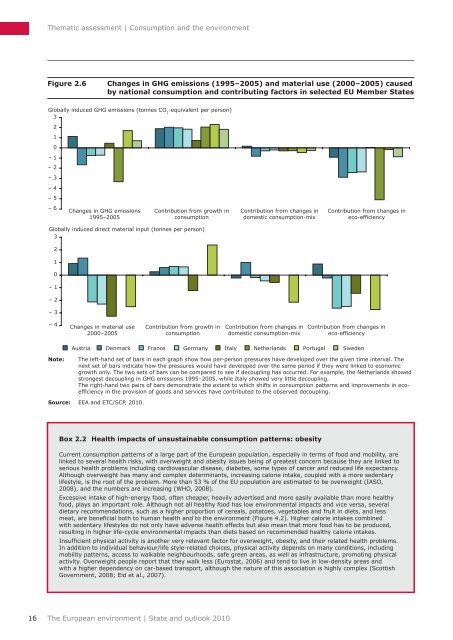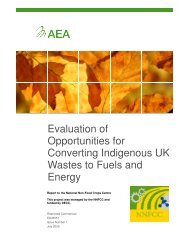Consumption and the environment (SOER2010) - European ...
Consumption and the environment (SOER2010) - European ...
Consumption and the environment (SOER2010) - European ...
You also want an ePaper? Increase the reach of your titles
YUMPU automatically turns print PDFs into web optimized ePapers that Google loves.
Thematic assessment | <strong>Consumption</strong> <strong>and</strong> <strong>the</strong> <strong>environment</strong><br />
Figure 2.6<br />
Changes in GHG emissions (1995–2005) <strong>and</strong> material use (2000–2005) caused<br />
by national consumption <strong>and</strong> contributing factors in selected EU Member States<br />
Globally induced GHG emissions (tonnes CO 2<br />
-equivalent per person)<br />
3<br />
2<br />
1<br />
0<br />
– 1<br />
– 2<br />
– 3<br />
– 4<br />
– 5<br />
– 6<br />
Changes in GHG emissions<br />
1995–2005<br />
Contribution from growth in<br />
consumption<br />
Globally induced direct material input (tonnes per person)<br />
3<br />
2<br />
1<br />
0<br />
– 1<br />
– 2<br />
– 3<br />
Contribution from changes in<br />
domestic consumption-mix<br />
Contribution from changes in<br />
eco-efficiency<br />
– 4<br />
Changes in material use<br />
2000–2005<br />
Contribution from growth in<br />
consumption<br />
Contribution from changes in<br />
domestic consumption-mix<br />
Contribution from changes in<br />
eco-efficiency<br />
Austria Denmark France Germany Italy Ne<strong>the</strong>rl<strong>and</strong>s Portugal Sweden<br />
Note:<br />
The left-h<strong>and</strong> set of bars in each graph show how per-person pressures have developed over <strong>the</strong> given time interval. The<br />
next set of bars indicate how <strong>the</strong> pressures would have developed over <strong>the</strong> same period if <strong>the</strong>y were linked to economic<br />
growth only. The two sets of bars can be compared to see if decoupling has occurred. For example, <strong>the</strong> Ne<strong>the</strong>rl<strong>and</strong>s showed<br />
strongest decoupling in GHG emissions 1995–2005, while Italy showed very little decoupling.<br />
The right-h<strong>and</strong> two pairs of bars demonstrate <strong>the</strong> extent to which shifts in consumption patterns <strong>and</strong> improvements in ecoefficiency<br />
in <strong>the</strong> provision of goods <strong>and</strong> services have contributed to <strong>the</strong> observed decoupling.<br />
Source: EEA <strong>and</strong> ETC/SCP, 2010.<br />
Box 2.2 Health impacts of unsustainable consumption patterns: obesity<br />
Current consumption patterns of a large part of <strong>the</strong> <strong>European</strong> population, especially in terms of food <strong>and</strong> mobility, are<br />
linked to several health risks, with overweight <strong>and</strong> obesity issues being of greatest concern because <strong>the</strong>y are linked to<br />
serious health problems including cardiovascular disease, diabetes, some types of cancer <strong>and</strong> reduced life expectancy.<br />
Although overweight has many <strong>and</strong> complex determinants, increasing calorie intake, coupled with a more sedentary<br />
lifestyle, is <strong>the</strong> root of <strong>the</strong> problem. More than 53 % of <strong>the</strong> EU population are estimated to be overweight (IASO,<br />
2008), <strong>and</strong> <strong>the</strong> numbers are increasing (WHO, 2008).<br />
Excessive intake of high-energy food, often cheaper, heavily advertised <strong>and</strong> more easily available than more healthy<br />
food, plays an important role. Although not all healthy food has low <strong>environment</strong>al impacts <strong>and</strong> vice versa, several<br />
dietary recommendations, such as a higher proportion of cereals, potatoes, vegetables <strong>and</strong> fruit in diets, <strong>and</strong> less<br />
meat, are beneficial both to human health <strong>and</strong> to <strong>the</strong> <strong>environment</strong> (Figure 4.2). Higher calorie intakes combined<br />
with sedentary lifestyles do not only have adverse health effects but also mean that more food has to be produced,<br />
resulting in higher life-cycle <strong>environment</strong>al impacts than diets based on recommended healthy calorie intakes.<br />
Insufficient physical activity is ano<strong>the</strong>r very relevant factor for overweight, obesity, <strong>and</strong> <strong>the</strong>ir related health problems.<br />
In addition to individual behaviour/life style-related choices, physical activity depends on many conditions, including<br />
mobility patterns, access to walkable neighbourhoods, safe green areas, as well as infrastructure, promoting physical<br />
activity. Overweight people report that <strong>the</strong>y walk less (Eurostat, 2006) <strong>and</strong> tend to live in low-density areas <strong>and</strong><br />
with a higher dependency on car-based transport, although <strong>the</strong> nature of this association is highly complex (Scottish<br />
Government, 2008; Eid et al., 2007).<br />
16<br />
The <strong>European</strong> <strong>environment</strong> | State <strong>and</strong> outlook 2010








